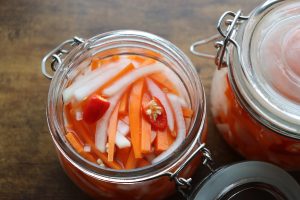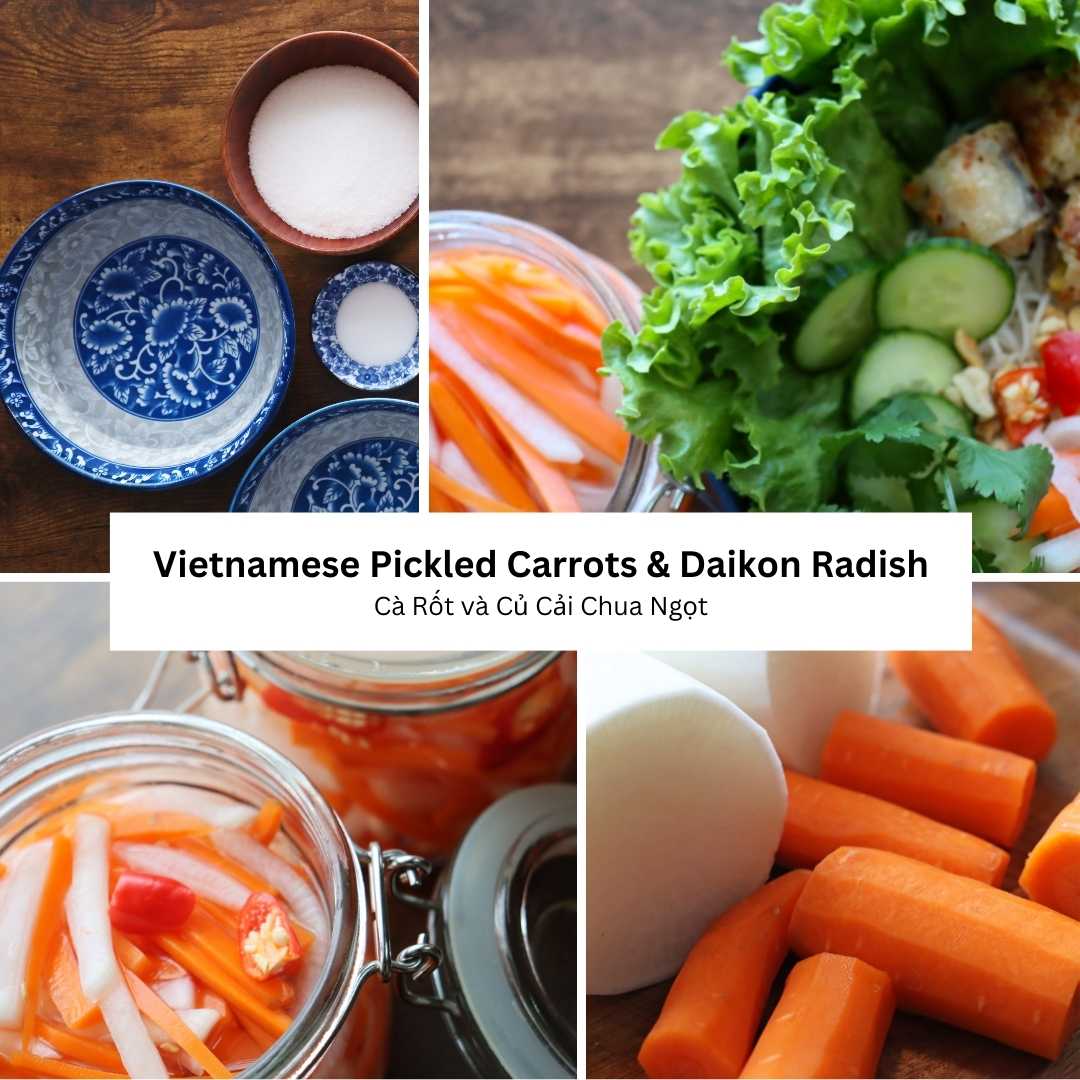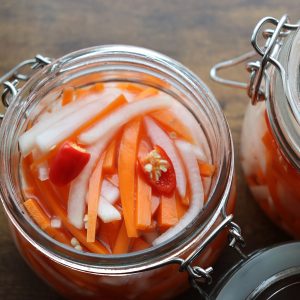Vietnamese Pickled Carrots & Daikon Radish (Cà Rốt & Củ Cải Chua Ngọt)

Pickled Carrots & Daikon Radish (Cà Rốt và Củ Cải Chua Ngọt) is a beloved condiment in Vietnamese cuisine. These pickled vegetables add the perfect balance to dishes like Vietnamese bánh mì, grilled meats, and fried favourites, providing a refreshing flavour and satisfying crunch. They work especially well to offset the rich, savoury profile of main dishes.
Making pickled carrots and daikon radish at home is simple and requires just a few ingredients: salt, sugar, water, and white vinegar. For a pop of colour and a bit of heat, Thai chilis are a great optional addition. The pickles are ready to enjoy after a day of marinating, and they keep well in the fridge. Try them in bánh mì, with rice or vermicelli dishes, or serve them as a bright, tangy side at family dinners.
Q&As on Vietnamese Pickled Carrots & Daikon Radish
1. Can I use a julienne tool to cut the carrot and radish instead of a knife to speed up the process?
While you can use a julienne tool for convenience, I recommend using a knife for this recipe. The reason is that I prefer the vegetables to be cut to a specific thickness – about 4-5 mm. Most julienne tools tend to create thinner strips, which can affect the texture of the pickles, making them softer rather than crisp. If your julienne tool allows you to adjust the thickness, it could work, but using a knife gives you more control to achieve the ideal size for this recipe.
2. Can I cut the carrot and radish into different shapes instead of julienne strips?
Absolutely! You can cut the carrot and radish into different shapes, as long as you keep the thickness consistent to ensure the vegetables pickle evenly and stay crisp. Feel free to get creative! You can use a crinkle knife for wavy edges or a flower mold tool to create fun, decorative shapes. These variations can add a playful touch to your pickles while maintaining their delicious crunch.

3. How long will pickled carrots and daikon radish last in the fridge?
Properly stored in a clean, sealed jar, pickled carrots and daikon radish can last for up to a month in the fridge. Make sure to use clean utensils when taking out the pickles to keep them fresh and prevent contamination. Over time, they may lose a bit of their crunch but will still be delicious and safe to eat within this period.
4. Can I make this recipe keto-friendly by avoiding sugar?
Yes, you can make this recipe keto-friendly by substituting the sugar with a keto-approved sweetener. Options like erythritol, allulose, or monk fruit sweetener work well and will still provide the sweet balance needed for the pickling brine. Keep in mind that these substitutes may slightly alter the flavour or texture, but the pickles will still turn out delicious and suitable for a keto diet.
5. How do you pronounce “Cà Rốt và Củ Cải Chua Ngọt?”
The pronunciation is: “Cah Roht vah Goo Gai Choo-ah Ngawt.”
Here’s a breakdown:
- Cà Rốt (carrot): “Cah Roht”
- Và (and): “Vah”
- Củ Cải (daikon radish): “Goo Gai”
- Chua Ngọt (sweet and sour): “Choo-ah Ngawt”
Say it slowly at first, then gradually speed up as you get more comfortable with the tones. Vietnamese pronunciation can vary slightly by region, but this is the standard way.

Recipe for Vietnamese Pickled Carrots & Daikon Radish
Equipment
- 1 small pot
- A few small glass jars with lid
Ingredients
- 325 grams daikon radish
- 325 grams carrot
- 1 tablespoon salt
- 6 tablespoons sugar
- 250 mL water
- 250 mL white vinegar
- 3 fresh Thai chilis
Instructions
- Peel the daikon radish and carrot. Cut them into julienne strips, about 4-5 mm thick, so they maintain a good crunch. Slice the Thai chilis into small pieces.
- Place the daikon and carrot strips in a mixing bowl. Sprinkle with 1 tablespoon of salt and toss until evenly coated. Allow the mixture to sit for 20 minutes, which helps draw out excess moisture, improving the pickles’ texture. Rinse the daikon and carrot thoroughly under cold water to remove the salt, then drain well.
- In a pot, combine 250 mL water, 250 mL white vinegar, and 6 tablespoons sugar. Stir until the sugar is dissolved. Bring the mixture to a gentle boil, then turn off the heat and let it cool to room temperature.
- In a clean, sterilized jar, layer the daikon and carrot strips along with the sliced Thai chilis. Pour the cooled vinegar mixture over the vegetables, ensuring they are fully submerged. Seal the jar tightly with a lid.
- Let the jar sit at room temperature for about 3 hours to allow the flavours to develop, then transfer it to the refrigerator. The pickled carrots and daikon radish can be served after a few hours but will taste best after marinating for at least a day.
- The pickles are now ready to serve! Use them as a side dish or add them to sandwiches, salads, or rice dishes for an extra burst of flavour. Refrigerate any leftovers; they will keep for up to a month when stored properly.

